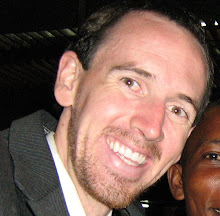Week 19 Sunday: the 4 Quarters, the Temple Mount, the Stations of the Cross, the Church of the Holy Sepulcher, and the Israel Museum
2.05.2009
We used 3 categories for everything we saw to distinguish how plausible it was that something actually happened in a particular location.
Categories
1. Category 1: There is archeological proof that this is logically the place where “it” occurred.
2. Category 2: Somewhere in between Category 1 and Category 3.
3. Category 3: Tradition states that this is where “it” took place. However, there is no archeological proof and usually there is 20 more feet of dirt on top of the location then there was during Jesus’ time (or whatever time we are talking about).
Old City (Jerusalem)
Sunday was our day inside Old City (Jerusalem). The Old City is only .34 square miles in size. However, that .34 square miles is divided into 4 Quarters: the Armenian (Christian), the Christian, the Jewish, and the Muslim.
The 4 Quarters
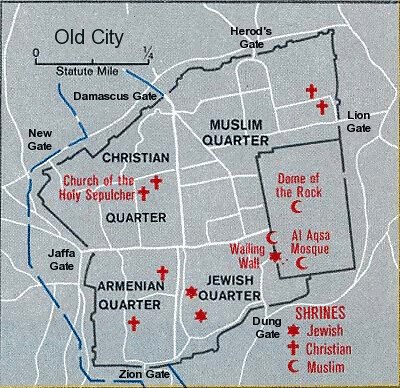
In all honesty, I was a wee bit confused as to which Quarter we were in sometimes. The difference between the Armenian and Christian Quarters was hard to distinguish. The simplest Quarter to recognize was the Jewish Quarter because walking down the alley was like walking down Rodeo Drive in California.
We entered the Old City through the Damascus Gate and walked right through the Jewish Quarter, past the Wailing Wall to the Temple Mount/Dome of the Rock. When we went from the Jewish Quarter to the Temple Mount (Muslim Quarter) we had to go through a security check point and could not bring our Bibles onto the Temple Mount.
The Muslim Quarter
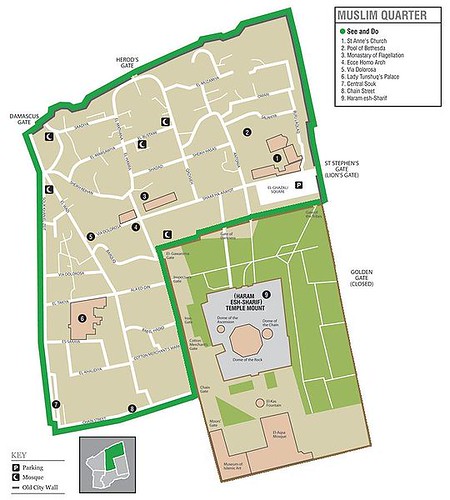
King David first purchased the Temple Mount (called Mount Moriah in the Bible) with the intention of building a temple to God there. He didn't, but his son Solomon built the First Temple in 960 BC which was then destroyed by Nebuchadrezzar II (coolest villain name ever!) of Babylon in 586 BC. Construction on the Second Temple began under Cyrus around 538 BC and was completed in 516 BC. The Second Temple was destroyed in 70 AD by the Romans. Efforts were made to rebuild the Temple, but known ever came to fruition.
In 691 AD, an octagonal Muslim building topped by a dome was built over the Rock. This is what is still there today, but they put gold over the dome in the 1920s. The Dome of the Rock is the third most holy place in Islam (after Mecca and Medina) because of Muhammad's nocturnal journey that is recorded in the Quran.
Story of Muhammad's nocturnal journey: Muhammad is met by Gabriel and taken to the farthest mosque (traditionally Temple Mount) where he goes up to heaven and meets with Abraham, Moses, and Jesus. Finally, Gabriel takes him to Allah. Allah tells him that Muslims must pray 50 times a day. However, Moses tells Muhammad that people will never do this so he must go back and ask Allah to lower the number. Muhammad goes back several times until the number is finally down to 5 times a day. Thus, the Temple Mount is the 3rd most holy place in Islam.
The Temple Mount is the holiest place in Judaism. Some Jews believe that the Rock is the Foundational Stone from which the world was created and expanded to its current form. Jews do not believe in going up to the Temple Mount because of its holiness (this is the simple way of explaining it). The Rock is traditionally where Isaac was almost sacrificed by Abraham and in Islam where Abraham almost sacrificed Ishmael. Some Jews believe the temple will be rebuilt when the Messiah comes, the Third Temple. There is a small minority who want to retake the Temple Mount for the Third Temple before the coming of the Messiah.
The Temple Mount is not viewed the same way by most Christians. It is viewed as the traditional place of many very important Biblically events. We left all of our arguing for the Church of the Holy Sepulcher.
Me and the Dome of the Rock:

The Armenian Quarter
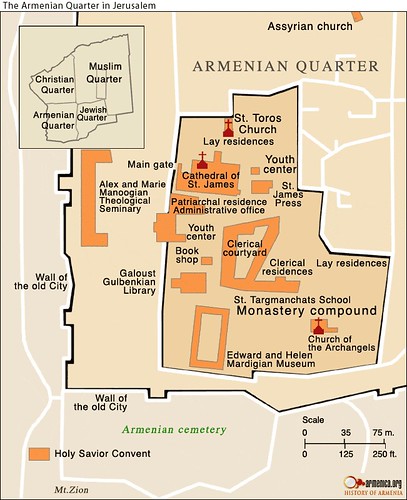
The Armenian Quarter is the smallest of the 4 Quarters. We walked through it very briefly.
The Christian Quarter
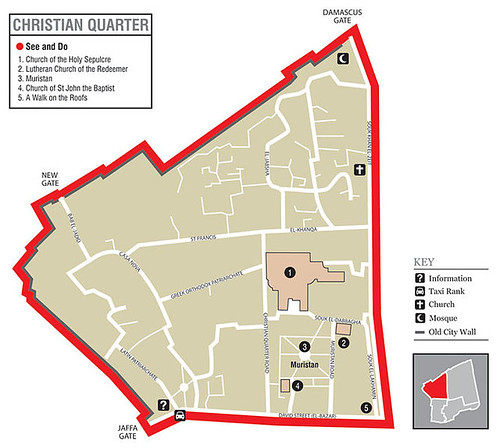
The Stations of the Cross
Being good Protestants, we were a bit confused attempting to do the Stations of the Cross, but it was still a surreal experience to walk where Jesus walked on his way to be crucified.
Along the way, the traditional location of each station are marked with a number.
Number marking the 9th Station of the Cross:
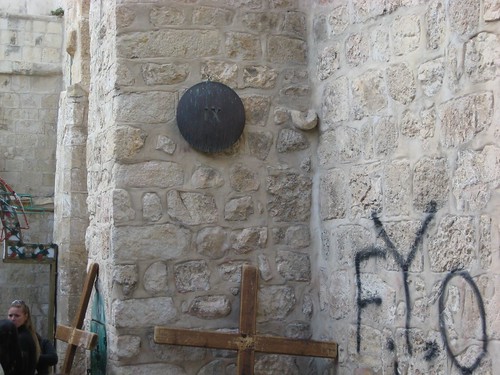
Stations of the Cross
- Jesus is condemned to death
- Jesus receives the cross
- Jesus falls the first time
- Jesus meets His Mother
- Simon of Cyrene carries the cross
- Veronica wipes Jesus' face with her veil
- Jesus falls the second time
- Jesus meets the daughters of Jerusalem
- Jesus falls the third time
- Jesus is stripped of His garments
- Crucifixion: Jesus is nailed to the cross
- Jesus dies on the cross
- Jesus' body is removed from the cross (Deposition or Lamentation)
- Jesus is laid in the tomb and covered in incense.
The Church of the Holy Sepulcher
The Church of the Holy Sepulcher is where Golgotha (the Hill of Calvary) is located. The location of Calvary is a category 1. Inside the church is the traditional place where Jesus was prepared to be buried, the Stone of Anointing, and also the traditional Tomb of Jesus. The Stone of Anointing and the Tomb are both category 3s.
This was the site that was the most surreal for me. I have found myself each day saying, "I have been to the place where Jesus was crucified." I'm not sure if it is the idea that I was at the actual place where Christ was crucified (category 1) or what, but this is the site that has had the biggest impact on me.
3 Stations of the Cross are all together around Calvary. Also, an interesting tradition I did not know is that Jesus was traditionally crucified over Adam's skull (Adam of Adam and Eve).
10. Jesus is stripped of His garments
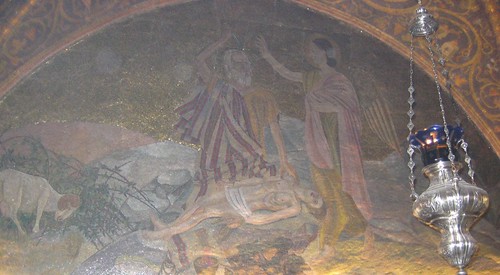
11. Crucifixion: Jesus is nailed to the cross

12. Jesus dies on the cross
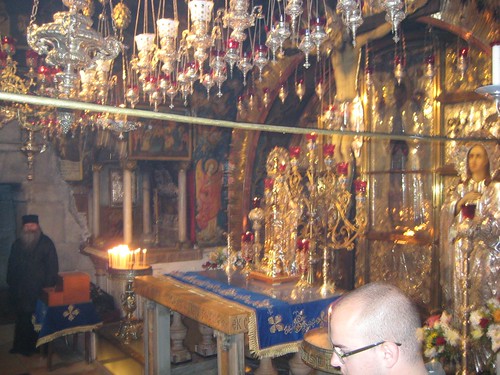
Video of Priests incensing 3 stations of the Cross (Calvary is the first stop):
The Church of the Holy Sepulcher is divided up mainly among the Eastern Orthodox, Armenian Apostolic, and Roman Catholic with the Eastern Orthodox having the best sites. The Coptic Orthodox, the Ethiopian Orthodox and the Syriac Orthodox acquired lesser responsibilities in the 19th century around the building. Conflict arises because all of these churches create what is called the status quo. Much of the Church of the Holy Sepulcher is common territory which all of the churches "share." The status quo requires all of the churches to agree when something must be done in the common territory. So, if you want to rearrange something in the common territory, then you have would have to get all 6 churches to agree. If you want to change a light bulb, you have to get all 6 churches to agree.
My favorite example is the "immovable ladder."
On the window ledge over the church's entrance there is a wooden ladder that someone put there before 1852. The doors and window ledges of the church are common territory. Therefore, the ladder has not been moved to this day because nobody claims ownership of the ladder and nobody will. So, the ladder has sat on the ledge for 150 years.
The Church of the Holy Sepulcher in 1885 (you can see the ladder below the left window above the door):

The Immovable Ladder in 1892:

The Immovable Ladder today:
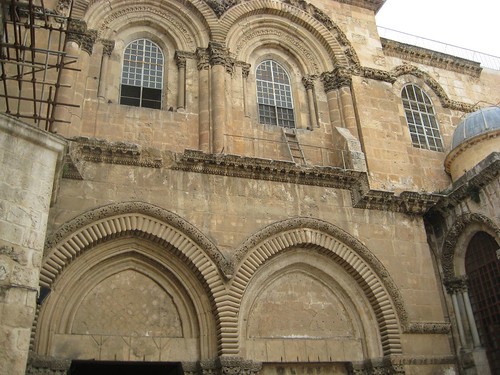
The Jewish Quarter
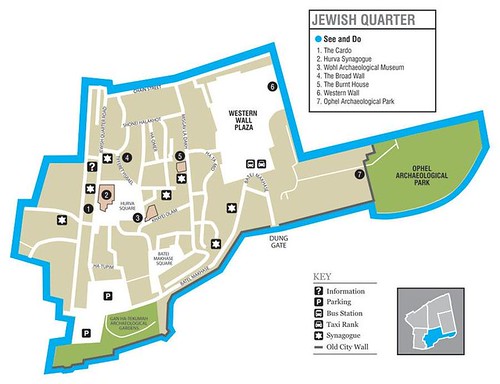
The Wailing Wall/Western Wall is believed to be the only remain of the Holy Temple. As I stated above, Jews may not set foot on the Temple Mount because of it is the holiest site in Judaism. Therefore, the Wailing Wall is the closest Jews can get to the Temple Mount without being on the Temple Mount. God's Presence in Jewish tradition is in the Wailing Wall. 18th century scholar Jonathan Eybeschutz writes that “after the destruction of the Temple, God removed His Presence from His sanctuary and placed it upon the Western Wall where it remains in its holiness and honor.” So, imagine how sacred a place would be if you believed that the Presence of God resided there.
The tradition of writing prayers down and placing them in the Wall did not originate until the 18th century. I wrote my own prayer and put it in the Wall. The Wall was completely covered in paper prayers. It was very impressive. There were several Jews sitting behind the Wall reciting the Torah which made me insecure about my Hebrew skills. It was an incredible experience.
The Wailing Wall:
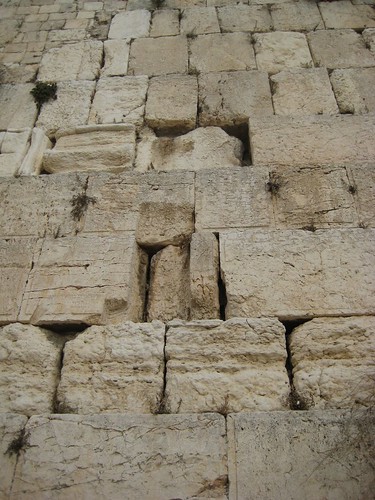
Me at the Wailing Wall (Up Close):
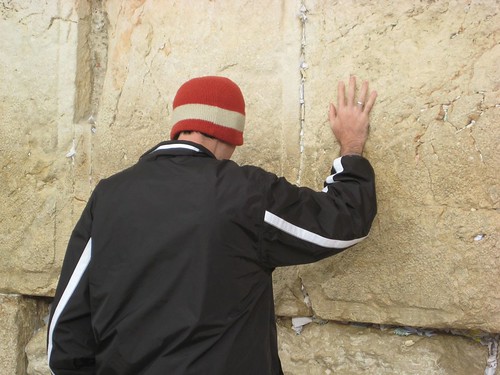
Me at the Wailing Wall (Half way):
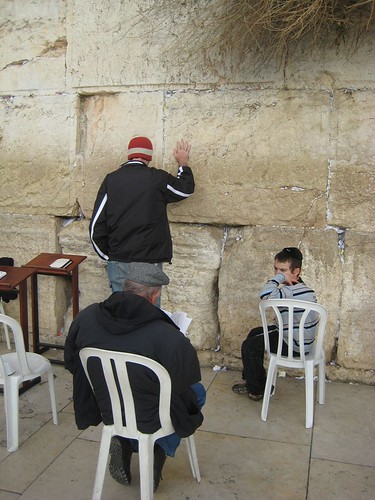
Me at the Wailing Wall (From a distance):
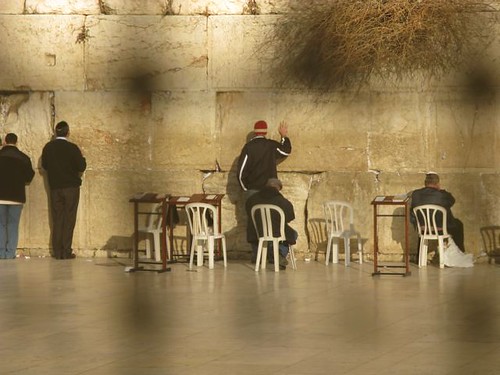
I had to leave the group a day early (because of flights) and was therefore missing out on a few sites on Monday. One of my goals was to go to see the Dead Sea Scrolls at the Israel Museum. However, I was VERY reluctant to spend money on a taxi and museum entrance fees, but my good friend Mary-Elizabeth helped me realize "we only live once" so I decided to take the chance. I am very glad that I did!
The Israel Museum was smaller than I envisioned, but extremely nice (as everything was in Israel). The Dead Sea Scrolls and other ancient Biblical documents were very impressive. I did not have a guide so it was a different experience compared to the rest of our tour. So, it wasn't every Dead Sea Scroll as I expected, but just part of one of the Scrolls. It was in a large room that had humidifiers and was well protected. I was still impressed.
The other cool part of the museum is an enormous model of Old Jerusalem during the Second Temple period (pic below).
Model of Old City (Jerusalem) during Second Temple at Israel Museum
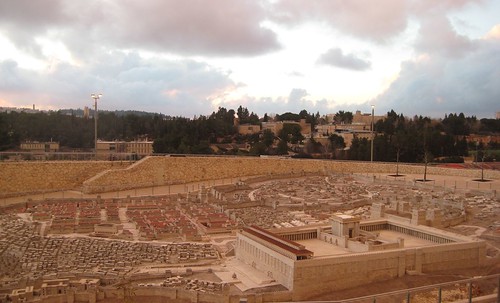
Sunset Last Night in Jerusalem from the Israel Museum:
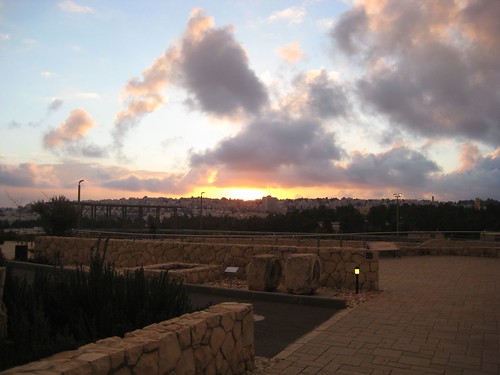
Our Professor very graciously had everyone meet that night so I could say my good-byes. The group prayed for me and I felt very loved. I also asked the group to donate feminine products (Mary-Elizabeth's idea) and first aid kits which was a great offering which some people in Kenya really appreciated. This will lead into my next blog post about being searched at the Israel airport with feminine products...
Have a great day!
RTQ
Categories
1. Category 1: There is archeological proof that this is logically the place where “it” occurred.
2. Category 2: Somewhere in between Category 1 and Category 3.
3. Category 3: Tradition states that this is where “it” took place. However, there is no archeological proof and usually there is 20 more feet of dirt on top of the location then there was during Jesus’ time (or whatever time we are talking about).
Old City (Jerusalem)
Sunday was our day inside Old City (Jerusalem). The Old City is only .34 square miles in size. However, that .34 square miles is divided into 4 Quarters: the Armenian (Christian), the Christian, the Jewish, and the Muslim.
The 4 Quarters

In all honesty, I was a wee bit confused as to which Quarter we were in sometimes. The difference between the Armenian and Christian Quarters was hard to distinguish. The simplest Quarter to recognize was the Jewish Quarter because walking down the alley was like walking down Rodeo Drive in California.
We entered the Old City through the Damascus Gate and walked right through the Jewish Quarter, past the Wailing Wall to the Temple Mount/Dome of the Rock. When we went from the Jewish Quarter to the Temple Mount (Muslim Quarter) we had to go through a security check point and could not bring our Bibles onto the Temple Mount.
The Muslim Quarter

King David first purchased the Temple Mount (called Mount Moriah in the Bible) with the intention of building a temple to God there. He didn't, but his son Solomon built the First Temple in 960 BC which was then destroyed by Nebuchadrezzar II (coolest villain name ever!) of Babylon in 586 BC. Construction on the Second Temple began under Cyrus around 538 BC and was completed in 516 BC. The Second Temple was destroyed in 70 AD by the Romans. Efforts were made to rebuild the Temple, but known ever came to fruition.
In 691 AD, an octagonal Muslim building topped by a dome was built over the Rock. This is what is still there today, but they put gold over the dome in the 1920s. The Dome of the Rock is the third most holy place in Islam (after Mecca and Medina) because of Muhammad's nocturnal journey that is recorded in the Quran.
Story of Muhammad's nocturnal journey: Muhammad is met by Gabriel and taken to the farthest mosque (traditionally Temple Mount) where he goes up to heaven and meets with Abraham, Moses, and Jesus. Finally, Gabriel takes him to Allah. Allah tells him that Muslims must pray 50 times a day. However, Moses tells Muhammad that people will never do this so he must go back and ask Allah to lower the number. Muhammad goes back several times until the number is finally down to 5 times a day. Thus, the Temple Mount is the 3rd most holy place in Islam.
The Temple Mount is the holiest place in Judaism. Some Jews believe that the Rock is the Foundational Stone from which the world was created and expanded to its current form. Jews do not believe in going up to the Temple Mount because of its holiness (this is the simple way of explaining it). The Rock is traditionally where Isaac was almost sacrificed by Abraham and in Islam where Abraham almost sacrificed Ishmael. Some Jews believe the temple will be rebuilt when the Messiah comes, the Third Temple. There is a small minority who want to retake the Temple Mount for the Third Temple before the coming of the Messiah.
The Temple Mount is not viewed the same way by most Christians. It is viewed as the traditional place of many very important Biblically events. We left all of our arguing for the Church of the Holy Sepulcher.
Me and the Dome of the Rock:

The Armenian Quarter

The Armenian Quarter is the smallest of the 4 Quarters. We walked through it very briefly.
The Christian Quarter

The Stations of the Cross
Being good Protestants, we were a bit confused attempting to do the Stations of the Cross, but it was still a surreal experience to walk where Jesus walked on his way to be crucified.
Along the way, the traditional location of each station are marked with a number.
Number marking the 9th Station of the Cross:

Stations of the Cross
- Jesus is condemned to death
- Jesus receives the cross
- Jesus falls the first time
- Jesus meets His Mother
- Simon of Cyrene carries the cross
- Veronica wipes Jesus' face with her veil
- Jesus falls the second time
- Jesus meets the daughters of Jerusalem
- Jesus falls the third time
- Jesus is stripped of His garments
- Crucifixion: Jesus is nailed to the cross
- Jesus dies on the cross
- Jesus' body is removed from the cross (Deposition or Lamentation)
- Jesus is laid in the tomb and covered in incense.
The Church of the Holy Sepulcher
The Church of the Holy Sepulcher is where Golgotha (the Hill of Calvary) is located. The location of Calvary is a category 1. Inside the church is the traditional place where Jesus was prepared to be buried, the Stone of Anointing, and also the traditional Tomb of Jesus. The Stone of Anointing and the Tomb are both category 3s.
This was the site that was the most surreal for me. I have found myself each day saying, "I have been to the place where Jesus was crucified." I'm not sure if it is the idea that I was at the actual place where Christ was crucified (category 1) or what, but this is the site that has had the biggest impact on me.
3 Stations of the Cross are all together around Calvary. Also, an interesting tradition I did not know is that Jesus was traditionally crucified over Adam's skull (Adam of Adam and Eve).
10. Jesus is stripped of His garments

11. Crucifixion: Jesus is nailed to the cross

12. Jesus dies on the cross

Video of Priests incensing 3 stations of the Cross (Calvary is the first stop):
The Church of the Holy Sepulcher is divided up mainly among the Eastern Orthodox, Armenian Apostolic, and Roman Catholic with the Eastern Orthodox having the best sites. The Coptic Orthodox, the Ethiopian Orthodox and the Syriac Orthodox acquired lesser responsibilities in the 19th century around the building. Conflict arises because all of these churches create what is called the status quo. Much of the Church of the Holy Sepulcher is common territory which all of the churches "share." The status quo requires all of the churches to agree when something must be done in the common territory. So, if you want to rearrange something in the common territory, then you have would have to get all 6 churches to agree. If you want to change a light bulb, you have to get all 6 churches to agree.
My favorite example is the "immovable ladder."
On the window ledge over the church's entrance there is a wooden ladder that someone put there before 1852. The doors and window ledges of the church are common territory. Therefore, the ladder has not been moved to this day because nobody claims ownership of the ladder and nobody will. So, the ladder has sat on the ledge for 150 years.
The Church of the Holy Sepulcher in 1885 (you can see the ladder below the left window above the door):

The Immovable Ladder in 1892:

The Immovable Ladder today:

The Jewish Quarter

The Wailing Wall/Western Wall is believed to be the only remain of the Holy Temple. As I stated above, Jews may not set foot on the Temple Mount because of it is the holiest site in Judaism. Therefore, the Wailing Wall is the closest Jews can get to the Temple Mount without being on the Temple Mount. God's Presence in Jewish tradition is in the Wailing Wall. 18th century scholar Jonathan Eybeschutz writes that “after the destruction of the Temple, God removed His Presence from His sanctuary and placed it upon the Western Wall where it remains in its holiness and honor.” So, imagine how sacred a place would be if you believed that the Presence of God resided there.
The tradition of writing prayers down and placing them in the Wall did not originate until the 18th century. I wrote my own prayer and put it in the Wall. The Wall was completely covered in paper prayers. It was very impressive. There were several Jews sitting behind the Wall reciting the Torah which made me insecure about my Hebrew skills. It was an incredible experience.
The Wailing Wall:

Me at the Wailing Wall (Up Close):

Me at the Wailing Wall (Half way):

Me at the Wailing Wall (From a distance):

I had to leave the group a day early (because of flights) and was therefore missing out on a few sites on Monday. One of my goals was to go to see the Dead Sea Scrolls at the Israel Museum. However, I was VERY reluctant to spend money on a taxi and museum entrance fees, but my good friend Mary-Elizabeth helped me realize "we only live once" so I decided to take the chance. I am very glad that I did!
The Israel Museum was smaller than I envisioned, but extremely nice (as everything was in Israel). The Dead Sea Scrolls and other ancient Biblical documents were very impressive. I did not have a guide so it was a different experience compared to the rest of our tour. So, it wasn't every Dead Sea Scroll as I expected, but just part of one of the Scrolls. It was in a large room that had humidifiers and was well protected. I was still impressed.
The other cool part of the museum is an enormous model of Old Jerusalem during the Second Temple period (pic below).
Model of Old City (Jerusalem) during Second Temple at Israel Museum

Sunset Last Night in Jerusalem from the Israel Museum:

Our Professor very graciously had everyone meet that night so I could say my good-byes. The group prayed for me and I felt very loved. I also asked the group to donate feminine products (Mary-Elizabeth's idea) and first aid kits which was a great offering which some people in Kenya really appreciated. This will lead into my next blog post about being searched at the Israel airport with feminine products...
Have a great day!
RTQ

